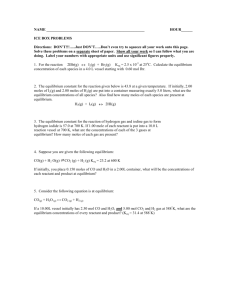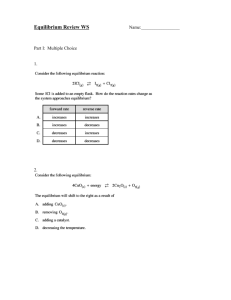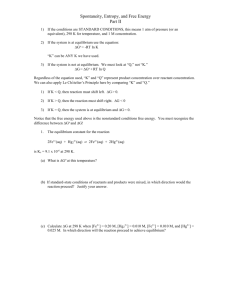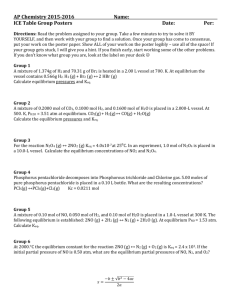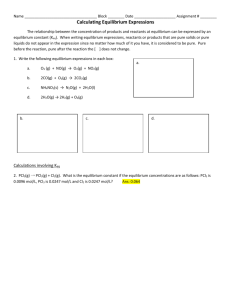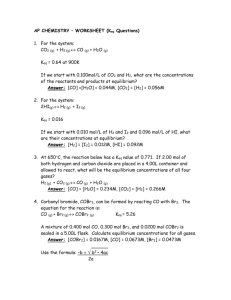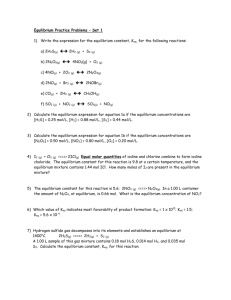Equilibrium Review
advertisement
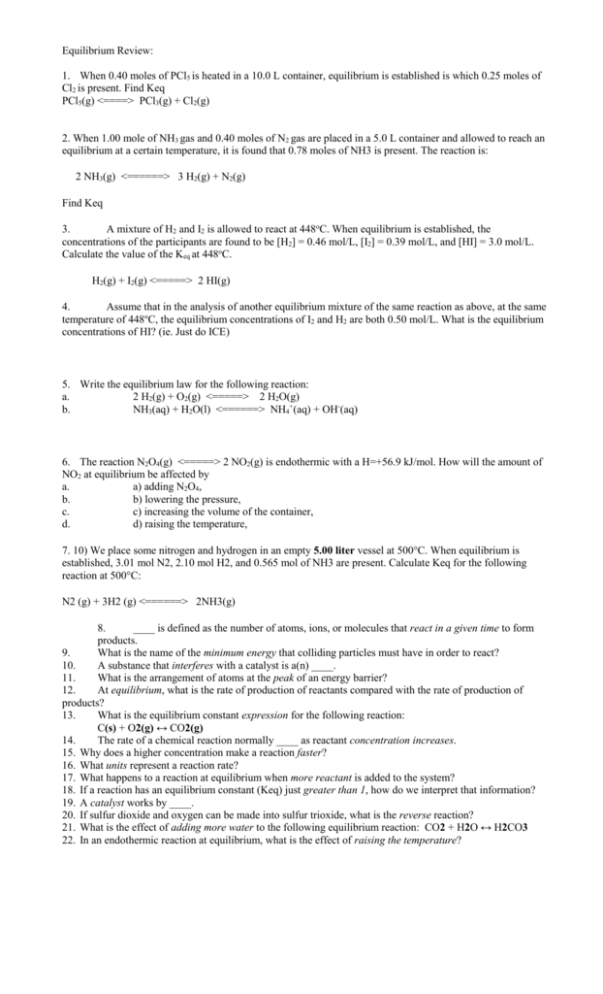
Equilibrium Review: 1. When 0.40 moles of PCl5 is heated in a 10.0 L container, equilibrium is established is which 0.25 moles of Cl2 is present. Find Keq PCl5(g) <====> PCl3(g) + Cl2(g) 2. When 1.00 mole of NH3 gas and 0.40 moles of N2 gas are placed in a 5.0 L container and allowed to reach an equilibrium at a certain temperature, it is found that 0.78 moles of NH3 is present. The reaction is: 2 NH3(g) <======> 3 H2(g) + N2(g) Find Keq 3. A mixture of H2 and I2 is allowed to react at 448oC. When equilibrium is established, the concentrations of the participants are found to be [H2] = 0.46 mol/L, [I2] = 0.39 mol/L, and [HI] = 3.0 mol/L. Calculate the value of the Keq at 448oC. H2(g) + I2(g) <=====> 2 HI(g) 4. Assume that in the analysis of another equilibrium mixture of the same reaction as above, at the same temperature of 448oC, the equilibrium concentrations of I2 and H2 are both 0.50 mol/L. What is the equilibrium concentrations of HI? (ie. Just do ICE) 5. Write the equilibrium law for the following reaction: a. 2 H2(g) + O2(g) <=====> 2 H2O(g) b. NH3(aq) + H2O(l) <======> NH4+(aq) + OH-(aq) 6. The reaction N2O4(g) <=====> 2 NO2(g) is endothermic with a H=+56.9 kJ/mol. How will the amount of NO2 at equilibrium be affected by a. a) adding N2O4, b. b) lowering the pressure, c. c) increasing the volume of the container, d. d) raising the temperature, 7. 10) We place some nitrogen and hydrogen in an empty 5.00 liter vessel at 500°C. When equilibrium is established, 3.01 mol N2, 2.10 mol H2, and 0.565 mol of NH3 are present. Calculate Keq for the following reaction at 500°C: N2 (g) + 3H2 (g) <======> 2NH3(g) 8. ____ is defined as the number of atoms, ions, or molecules that react in a given time to form products. 9. What is the name of the minimum energy that colliding particles must have in order to react? 10. A substance that interferes with a catalyst is a(n) ____. 11. What is the arrangement of atoms at the peak of an energy barrier? 12. At equilibrium, what is the rate of production of reactants compared with the rate of production of products? 13. What is the equilibrium constant expression for the following reaction: C(s) + O2(g) ↔ CO2(g) 14. The rate of a chemical reaction normally ____ as reactant concentration increases. 15. Why does a higher concentration make a reaction faster? 16. What units represent a reaction rate? 17. What happens to a reaction at equilibrium when more reactant is added to the system? 18. If a reaction has an equilibrium constant (Keq) just greater than 1, how do we interpret that information? 19. A catalyst works by ____. 20. If sulfur dioxide and oxygen can be made into sulfur trioxide, what is the reverse reaction? 21. What is the effect of adding more water to the following equilibrium reaction: CO2 + H2O ↔ H2CO3 22. In an endothermic reaction at equilibrium, what is the effect of raising the temperature?
